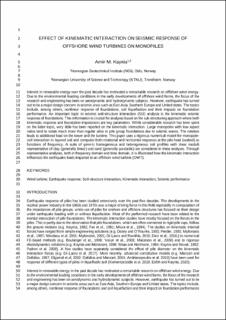Effect of kinematic interaction on seismic response of offshore wind turbines on monopiles
Peer reviewed, Journal article
Accepted version

Åpne
Permanent lenke
https://hdl.handle.net/11250/2685132Utgivelsesdato
2020Metadata
Vis full innførselSamlinger
Originalversjon
10.1002/eqe.3371Sammendrag
Interest in renewable energy over the past decade has motivated a remarkable research on offshore wind energy. Due to the environmental loading conditions in the early developments of offshore wind farms, the focus of the research and engineering has been on aerodynamic and hydrodynamic subjects. However, earthquake has turned out to be a major design concern in seismic areas such as East Asia, Southern Europe, and United States. The topics include, among others, nonlinear response of foundations, soil liquefaction, and their impacts on foundation performance. An important topic in seismic soil‐structure interaction (SSI) analysis is the kinematic seismic response of foundations. This information is crucial for analyses based on the substructuring approach where both kinematic response and foundation impedances are key parameters. While considerable research has been spent on the latter topic, very little has been reported on the kinematic interaction. Large monopoles with low aspect ratios tend to rotate much more than regular piles in pile group foundations due to seismic waves. The rotation leads to additional load on the tower and the turbine. This article uses a rigorous numerical model for monopole‐soil interaction in layered soil and computes both rotational and horizontal responses at the pile head (seabed) as functions of frequency. A suite of generic homogeneous and heterogeneous soil profiles with shear moduli representative of clay (generally linear) and sand (generally parabolic) are considered in these analyses. Through representative analyses, both in frequency domain and time domain, it is illustrated how the kinematic interaction influences the earthquake loads imparted to an offshore wind turbine (OWT).